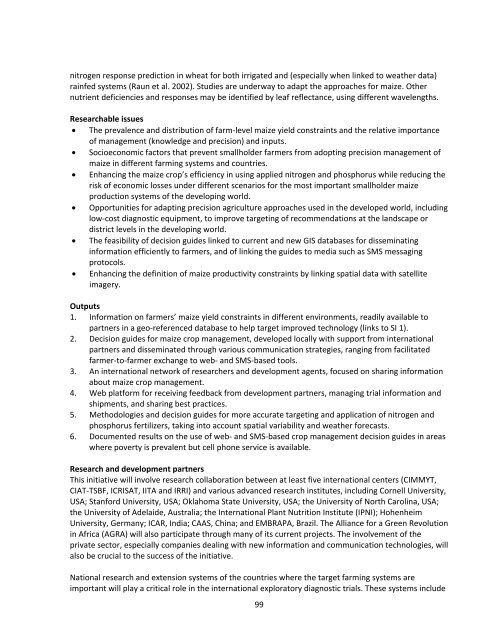Download - Maize
Download - Maize
Download - Maize
You also want an ePaper? Increase the reach of your titles
YUMPU automatically turns print PDFs into web optimized ePapers that Google loves.
nitrogen response prediction in wheat for both irrigated and (especially when linked to weather data)<br />
rainfed systems (Raun et al. 2002). Studies are underway to adapt the approaches for maize. Other<br />
nutrient deficiencies and responses may be identified by leaf reflectance, using different wavelengths.<br />
Researchable issues<br />
The prevalence and distribution of farm‐level maize yield constraints and the relative importance<br />
of management (knowledge and precision) and inputs.<br />
Socioeconomic factors that prevent smallholder farmers from adopting precision management of<br />
maize in different farming systems and countries.<br />
Enhancing the maize crop’s efficiency in using applied nitrogen and phosphorus while reducing the<br />
risk of economic losses under different scenarios for the most important smallholder maize<br />
production systems of the developing world.<br />
Opportunities for adapting precision agriculture approaches used in the developed world, including<br />
low‐cost diagnostic equipment, to improve targeting of recommendations at the landscape or<br />
district levels in the developing world.<br />
The feasibility of decision guides linked to current and new GIS databases for disseminating<br />
information efficiently to farmers, and of linking the guides to media such as SMS messaging<br />
protocols.<br />
Enhancing the definition of maize productivity constraints by linking spatial data with satellite<br />
imagery.<br />
Outputs<br />
1. Information on farmers’ maize yield constraints in different environments, readily available to<br />
partners in a geo‐referenced database to help target improved technology (links to SI 1).<br />
2. Decision guides for maize crop management, developed locally with support from international<br />
partners and disseminated through various communication strategies, ranging from facilitated<br />
farmer‐to‐farmer exchange to web‐ and SMS‐based tools.<br />
3. An international network of researchers and development agents, focused on sharing information<br />
about maize crop management.<br />
4. Web platform for receiving feedback from development partners, managing trial information and<br />
shipments, and sharing best practices.<br />
5. Methodologies and decision guides for more accurate targeting and application of nitrogen and<br />
phosphorus fertilizers, taking into account spatial variability and weather forecasts.<br />
6. Documented results on the use of web‐ and SMS‐based crop management decision guides in areas<br />
where poverty is prevalent but cell phone service is available.<br />
Research and development partners<br />
This initiative will involve research collaboration between at least five international centers (CIMMYT,<br />
CIAT‐TSBF, ICRISAT, IITA and IRRI) and various advanced research institutes, including Cornell University,<br />
USA; Stanford University, USA; Oklahoma State University, USA; the University of North Carolina, USA;<br />
the University of Adelaide, Australia; the International Plant Nutrition Institute (IPNI); Hohenheim<br />
University, Germany; ICAR, India; CAAS, China; and EMBRAPA, Brazil. The Alliance for a Green Revolution<br />
in Africa (AGRA) will also participate through many of its current projects. The involvement of the<br />
private sector, especially companies dealing with new information and communication technologies, will<br />
also be crucial to the success of the initiative.<br />
National research and extension systems of the countries where the target farming systems are<br />
important will play a critical role in the international exploratory diagnostic trials. These systems include<br />
99

















